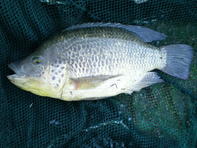In South Africa, the commercial production of saltwater finfish species is limited but has the potential to grow, provided there is a combination of far-sighted long-term investors, market development and good site selection. Below is a short overview of finfish species that have commercial potential for marine aquaculture in South Africa.

Spotted Grunter
Great tasting spotted grunter (Pomadasys commersonnii) feed on small aquatic animals such as sandprawns and worms in the sand of shallow seawater or estuaries. Mature, wild grunters can reach 87 cm weighing up to 9.5 kg. These fish can be farmed in salt water ponds but can also tolerate fresh water.
Dusky Kob
Dusky kob or Argyrosomus japonicusis is also called ‘boer-kabeljou’ or ‘dagga salmon’. It is related to silver kob but grows faster.
Dusky kob is a large fish that can grow up to 1.8 m, weighing 75 kg, and is very popular with line fishermen in shallow waters along the South African coast from Cape Point to Mozambique. Juveniles are often found in estuaries. The dusky kob is suitable for farming in ‘RAS’ tanks (recirculating aquaculture systems), cages or in closed-off sections of rivers.
Dusky kob has a rapid growth rate, taste very good and high market demand, the species was identified as a suitable aquaculture candidate species. It can reach a marketable size of 1kg within 12 to 14 months, depending on temperature and water conditions.
Currently (2019), production costs for dusky kob are high, local sales prices are low and the current local demand for linefish do not justify large-scale dusky kob production of more than 1 000 tonnes per year.
The government-run Hamburg Aquaculture Project in the Eastern Cape started stocking dusky kob fingerlings in 2015 and produced 989 kg of marketable fish. According to the Department of Agriculture, Forestry & Fisheries (DAFF) in June 2019, no commercial quantities of dusky kob have since been produced at Hamburg. The privately-owned Zini Fish Farms in KwaZulu-Natal also produces dusky kob.
A partnership between the Department of Science and Technology (DST) and Stellenbosch University (SU) produced 22 tonnes of dusky kob in sea-cages off Richard’s Bay. To date, production has not been successful on a commercial scale.
Saltwater Tilapia
The salt-tolerant Mozambican tilapia (Oreochromis mossambicus) has great potential as a commercial finfish species in South Africa, says Neil Stallard, director of Zini Fish Farms in KwaZulu-Natal. Grown in saltwater in earthen ponds, it is comparable to the popular Nile tilapia (grown in freshwater). Nile tilapia is considered an alien species and special permits are required to farm this fish. Mozambican tilapia is, however, indigenous to Southern Africa and permits are obtainable from the local conservation agency.
Saltwater Mozambican tilapia can grow from egg to marketable size in about 12 months and will be available in the informal market and some restaurants. Volumes will start at 2 tonnes/month from January 2020, increasing to 10 tonnes/month from June 2020.
Ocean Trout
Molapong Aquaculture, assisted by the DAFF’s Operation Phakisa, farms ocean trout in sea-cages in Saldanha Bay on South Africa’s West Coast. This project aims to grow from 500 tons to 2 000 tons of trout (and salmon) 2019.
Ocean trout is a different strain from freshwater rainbow trout, it grows larger and tastes more like salmon, but not as oily.
Trials for farming ocean trout have also been done in Hermanus and Paternoster. According to Dane Kieser of Molapong Aquaculture, ocean trout fish production is for local markets, but their ocean trout eggs are used both locally and exported all over the world.
Atlantic Salmon
The application for an on-shore salmon farm in Betty’s Bay, about 100 km east of Cape Town was withdrawn in January 2019 as a less sensitive site has been found. The salmon farm planned to use recirculating aquaculture systems (RAS) and also included a hatchery, processing plant and water treatment units. Annual production of 4 000 tonnes was predicted.
In South Africa, possible zones for Atlantic salmon cage culture are Gansbaai and Saldanha Bay. These sites are suitable due to water temperature, upwelling currents, wave exposure, and water clarity. Molapong Aquaculture has permits to produce Atlantic salmon in sea-cages in Saldanha Bay and a single batch of coho salmon (or ‘silver salmon’) was produced in 2017, says Dane Kieser, production manager of Molapong Aquaculture. Production of Atlantic salmon, together with that of ocean trout, is estimated to reach 2 000 tonnes in 2019, for local consumption.
Barramundi
The farming of barramundi (Lates calcarifer) or Asian sea bass, is proposed for the Amatikulu Aquaculture Development Zone (ADZ) 120 km north of Durban in the warm KwaZulu-Natal Province, but according to DAFF, no barramundi is yet farmed in South Africa.
A member of the sea bass family, barramundi is native to Australia and Southeast Asia. It is a robust fish that can grow to a marketable 700 - 900 g size within 12 months. The fish has a sweet buttery taste, with a firm flaky texture. Commercial farming of barramundi in Australia is in open-ocean cages. In the wild, it is a river species that breed in estuaries.
By Marinda Louw
For bulk or export enquiries please use the enquiry link below.